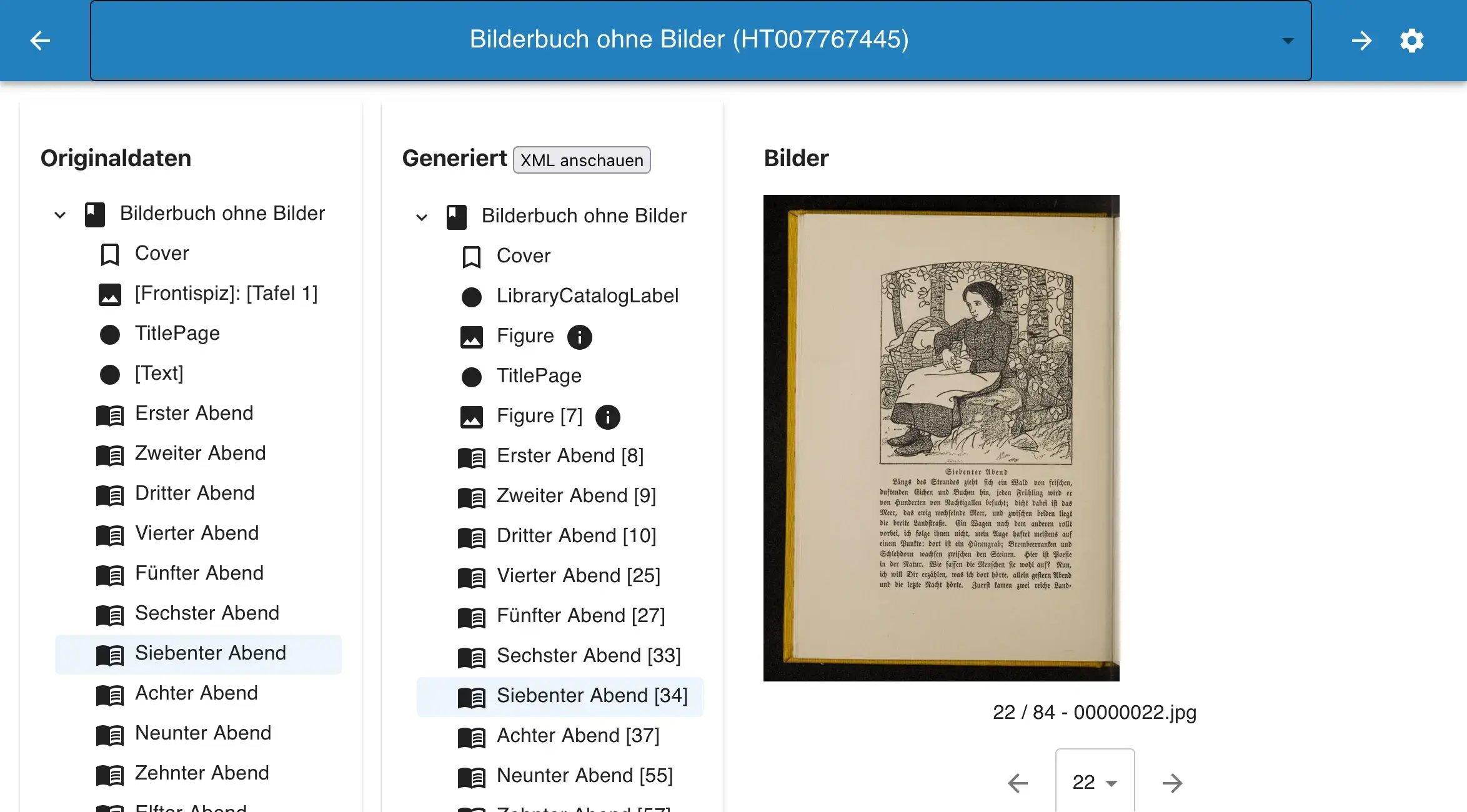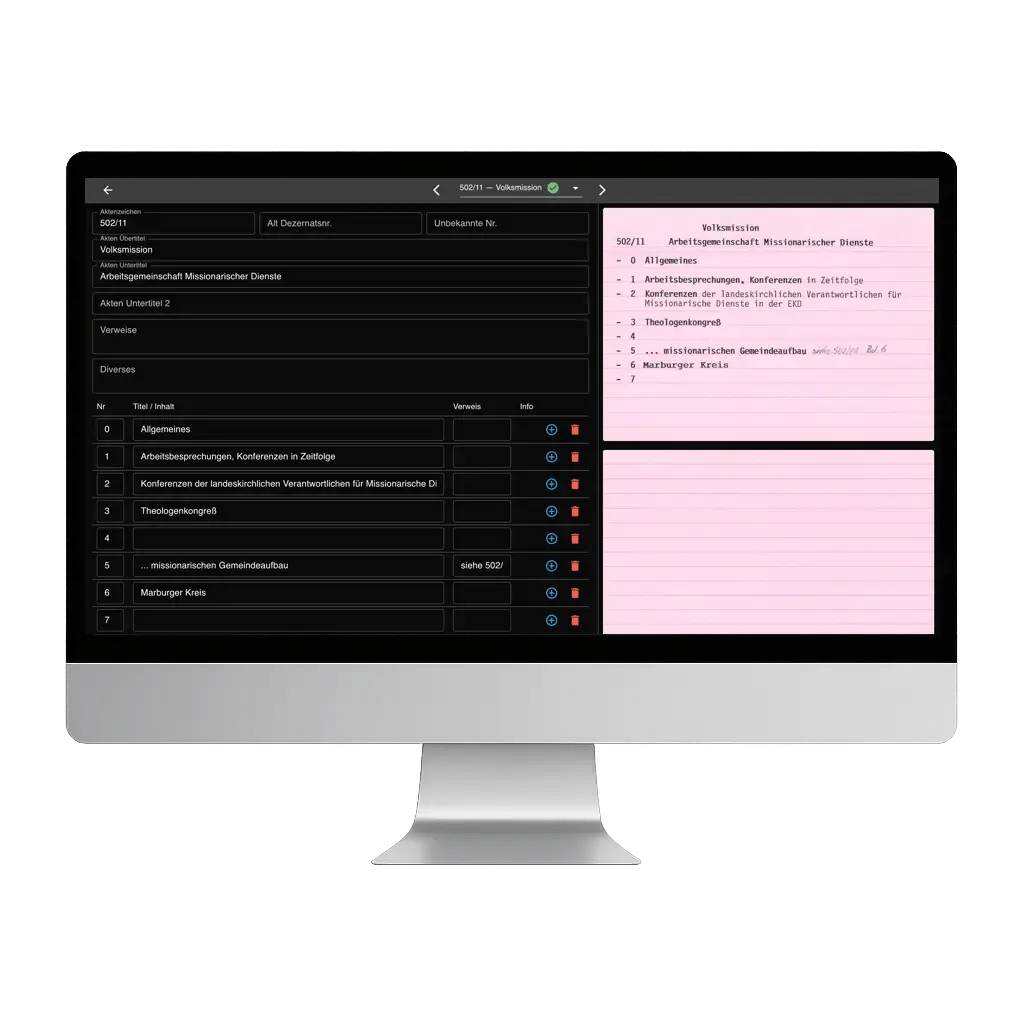
Evangelical Church Palatinate – From Card Catalog to Data Repository

How the Central Archive of the Evangelical Church of the Palatinate made the Central Registry’s finding aid digitally accessible in a matter of weeks
 Web interface for direct comparison between scans and data, enabling expedited processing.
Web interface for direct comparison between scans and data, enabling expedited processing.
Until now, the finding aid of the Central Registry of the Church Council of the Evangelical Church of the Palatinate consisted of two series of index cards – a keyword card catalog and a card catalog organized according to the registry plan. All metadata existed in analogue form, and further work in the Central Registry remained largely analogue.
To enable contemporary workflows and research, and to reuse the existing metadata for archival purposes, a digital shift in the Central Registry’s processes was both indispensable and long overdue.
As a fundamental first step in overhauling those workflows, a digital working foundation had to be established. Traditionally, this would have begun with manually transferring the metadata from the index cards into the database. In the case of the Central Registry’s card index, however, the Central Archive in Speyer decided instead to launch a small-scale AI-supported pilot project.
The reasons for this decision are manifold; here are just a few aspects:
- Contemporary handling of legacy finding aids without off-putting, outdated tasks for new staff.
- A testing ground for ideas to optimize synergies through digitization.
- Curiosity about what AI-supported processes can—and cannot—achieve; gaining practical experience within a manageable project.
Initial Situation and Objectives
Initially, the archive scanned the index cards in-house according to the service provider’s specifications. A small, easy-to-use document flatbed scanner with an automatic feeder was sufficient to complete this task quickly. More time was required to locate “challenging special cases” among the cards, which deviated significantly from the standard template and served, among other things, as test files.
The file, comprising a total of 3,096 scans of 1,548 DIN A5 index cards, was intended to serve as the basis for the AI-assisted conversion of machine-printed index cards with handwritten annotations into an Excel file.
The Decision Formula: Human AND Machine
Archipanion preprocessed the scans by pairing front and back images, performed field extraction using a large language model (LLM), and standardized the formats. After a few test runs, this succeeded in many cases where the cards deviated little from the basic structure.
For cards whose structure deviated significantly, the AI understandably reached its limits. Semantic interpretation of handwritten annotations and the assignment of notes remained manual tasks. To capture as much information from the analogue cards as possible, a very thorough quality control process was chosen, in which each scan was compared to the metadata generated in the spreadsheet.
To make this as user-friendly as possible, Archipanion provided a web front end for direct comparison of scans and generated entries, into which corrections could be entered directly. This enabled the resource-intensive quality control to be performed at a very high level, in a modern way, and within a manageable timeframe. Missing or misassigned information could be quickly and easily added and simultaneously checked for archival plausibility. The quality control was completed by the registry clerk within six weeks.
Key Project Metrics and Processing Details
| Metric | Value |
|---|---|
| Cards processed | 1,548 |
| Perfectly recognized (no errors) | 481 cards (31 %) |
| Minimal corrections (≤ 5 % CER) | 926 cards (60 %) |
| Average error rate (CER) | 7.27 % |
| Fields recognized perfectly | 89 % |
| Time for QC | approx. 6 weeks |
Note on the error rate: the measurement is conservative. During quality control, additional errors in the original finding aid were corrected or updated (e.g., spellings, classifications). These improvements are not calculated separately and therefore appear in the CER statistic, meaning the actual data quality is higher.
Examples
 Cards like these were recognized perfectly.
Cards like these were recognized perfectly.
 For such cards, human expertise is required—not for character recognition, but to interpret and decide which information to record.
For such cards, human expertise is required—not for character recognition, but to interpret and decide which information to record.
 Even with non-standard layouts, unexpected fields can be manually supplemented.
Even with non-standard layouts, unexpected fields can be manually supplemented.
Four Key Lessons Learned
- Structure is key
Cards that adhere to the prescribed layout were correctly recognized with minimal corrections. Handwritten annotations and deviations remain challenging but are common in legacy collections and must be factored into quality control. - User-friendliness makes the difference
The integrated control interface spared team members the “Excel-scan ping-pong”— a clear gain in comfort and time compared to conventional quality checks. - AI is a process, not a product
“We now know what we can realistically expect—and where professional judgment remains indispensable,” summarizes the project manager. Automation handles rote tasks and helps modernize archival processing workflows, allowing manual work to focus increasingly on expert tasks. - Significantly reduced time investment despite errors
Errors occurred during AI preprocessing that would also arise in a manual workflow. However, the nature of the errors is more limited and less varied. Moreover, the time savings from automated processing are unbeatable. The error rate can thus be further reduced through subsequent QC with significantly less time investment.
The Outcome
- Excel file in the target format is available.
- Data can be used with confidence because professional quality has significantly improved.
- The team has gained hands-on understanding of how AI and subject-matter expertise interact.
The Benefits – in a Matter of Weeks
- Searchability
Analogue registers become a digitally searchable database. - Quality leap
Incorrect or outdated entries can be corrected directly. - Knowledge building
Staff gain routine in the interplay of AI and archival practice.
Conclusion
The pilot clearly shows: AI excels where it takes on rote tasks and creates more time for professional work. From 1,548 index cards, searchable datasets were produced in a matter of weeks – without aiming to replace human expertise, but rather to strengthen it. For the project manager, this represents a step toward a modern, digitally operating archive that makes the possibilities of data processing usable for archival purposes.
How Can You Get Started?
Your 30-minute “Status & Goals Briefing” brings clarity:
- Analyze initial situation – Which analogue holdings and finding aids are available?
- Prioritize objectives – Which workflow improvements is your team seeking?
- Assess potential – Where can AI-supported processes provide concrete support?
Outcome: A clear picture of your situation and a realistic initial assessment – what is possible? Which next steps, e.g. an in-depth workshop or a pilot, are worthwhile?
Note: This article is a translation of the original German text, assisted by AI and reviewed by us.

